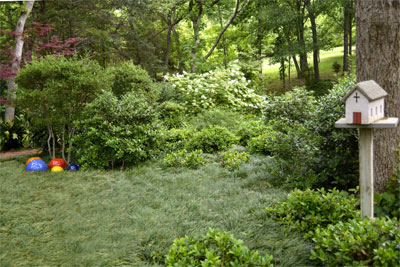Sperry Backyard

Ever wonder what to do when you have lots of shade? Here is information Neil has posted on his Facebook page, under “Notes.”
If your trees grow the way you hope they will, sooner or later, you’re likely to run into issues with turfgrass that is thinning and flowers that aren’t blooming.
My family lives in a pecan forest, and we’ve gone through those stages of “full-sun-transitioning-into-full-shade” landscaping. Plants that I chose to grow in full sun gradually found themselves, instead, in full shade. And, they weren’t the least bit pleased with the changes. Here are some notes of how I’ve handled the situation at our house. Perhaps they’ll be of help as you face the same issues.
My first step was to rethink our design. How much turf did I really need anyway. Our kids are grown, and play areas aren’t as critical – until the grandkids come by for a visit. There are other places where we could set up a quick yard game if we needed to. That meant that those former turf areas that no longer could handle the shade could now be turned over to groundcovers.
Where St. Augustine, our most shade-tolerant turfgrass, needs at least four hours of direct sunlight daily to maintain itself status quo, there are groundcovers that need no direct sunlight. I’ve used mondograss most plentifully. I like its soft, grass-like texture. It stays short, to 6 to 8 inches tall, and it forms a dense planting in a hurry. It’s especially good at holding soil on slopes. I’ve also used a lot of Asian jasmine and purple wintercreeper euonymus, two of our best full-sun groundcovers. They also do well in shade.
I use two other knee-high plants as tall groundcovers, or in lieu of shrubs. Wood fern serves mightily. It’s a lovely fine-textured fern that grows to 18 to 24 inches tall. Other ferns are also available, but wood fern has been my “go-to” performer. I also have a lot of cast iron plant (aspidistra). It’s among the coarsest-textured plants that we grow. It’s especially pretty when I grow it alongside the aforementioned wood ferns. I do have to cover the aspidistra in winter cold spells, however. It’s not too happy with North Texas extremes.
Sometimes, however, you want to leave the turf right where it is, yet the shade is still causing you grief. What are the alternatives? Try removing any sick or undesirable trees. Usually there are a few plants that have outlived their usefulness. While you should never remove a contributing part of a garden, if a tree is misshapen or lethargic, get it out of the way and let the sun shine on through.
Other times, you may want to remove lower limbs from large shade trees. That’s especially possible for tall, arching trees like pecans, red oaks, soapberries and pistachios. It’s much more difficult with spreading trees like mulberries, live oaks and hackberries where lower limbs are parallel to the ground. Where it does work, however, removing just one or two limbs can really make a difference in the quality of turfgrass below.
If you need shrubs that can hold up to the shade, choose first from the many, many types of hollies. With mature heights ranging from 2 to 20 or more feet, there is a holly for literally any type of landscaping need. Use several types, and cluster them in natural woodland groupings beneath your large trees. Your nurseryman can suggest the best types.
Other dependable shade performers include cleyera, fatsia and the several mahonias. Each of these plants brings a special charm to its surroundings. Whether you want the glossy, polished look of the cleyera foliage or the large and bold texture of the fatsias, you’ll have show plants for your gardens. Mahonias are related to nandinas, and they share the same bold and upright, somewhat stemmy appearance.
Oakleaf hydrangeas are sensational woody shrubs. Their dinner plate-sized leaves are dark green all summer, turning crimson in late fall. The floral bracts are large and lovely white. The plants thrive in the shade, and they grow to 5 or 6 feet tall and equally wide.
Color becomes a bit of a challenge in the shade garden. Impatiens will bloom well where they get morning sun and afternoon shade, but they’ll “go all to leaves” if they’re in heavy shade. Begonias aren’t a lot different, and cutting-grown coleus varieties will also color best with half a day of sunlight. If you have really heavy shade and you want warm-season color, you probably ought to stick with caladiums, long-time proven performers in southern shade gardens. Try the strap-leafed types as well. They stay perky for several weeks more than the old-fashioned “fancy-leafed” types.
I use textures as a substitute for color in our shade gardens. I use tropical plants with their wild and curious leaves, many attractively variegated. Ferns and philodendrons. Crotons and colocasias. You can create a fabulous landscape using nothing but foliage.
Shade need be no major worry as it evolves in your landscape. All it requires is a little foresight and planning. This might be the year you decide to make those necessary changes.

